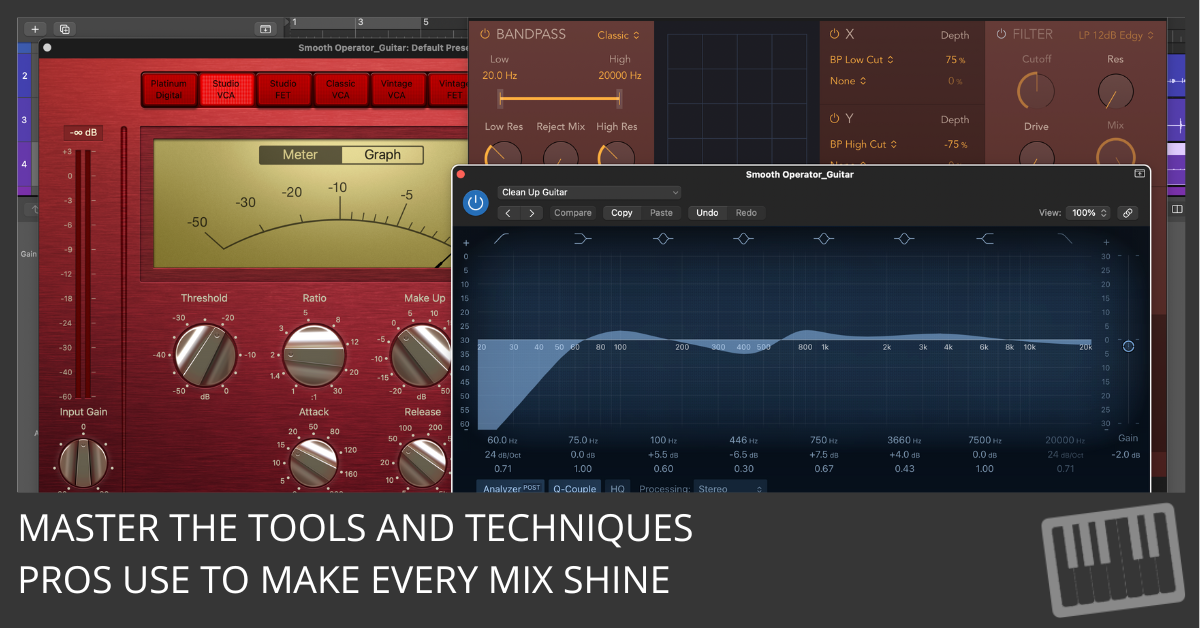
If your mixes feel flat or muddy, it’s not your gear—it’s your process. Let’s fix that.
Mixing is about balance: balancing volume, panning, frequency, and depth to make every element shine without overpowering the whole.
Whether you’re working on Logic Pro, Ableton, or Pro Tools, these five steps will help you craft mixes that sound polished, dynamic, and professional.
1. Set Your Volume Levels: The Foundation of Every Mix
Volume is the backbone of your mix. Before you get fancy with EQs or effects, you need to nail the basics. Here’s how to get started:
- Trim First: Use your DAW’s gain plugin to adjust trim levels so all tracks peak between -12 and -18 dBFS. This gives you headroom and prevents clipping later.
- Balance by Ear: Find the loudest part of your track (usually the chorus) and start balancing levels there. Solo your drums and bass first, then add other instruments one by one.
- Avoid the “No Fly Zone”: Nothing should peak above -6 dBFS during mixing. Think of this as your safety net.
Example:
Let’s say your snare is hitting too hard at -3 dBFS. Drop the trim level down to -18 dBFS, then slowly bring it back up until it punches without dominating the mix.
2. Pan Like a Pro: Creating Width and Clarity
Panning creates space in your mix. Without it, your tracks will sound cramped and lifeless. Use panning to distribute instruments across the stereo field.
- Start with the Big Three: Keep kick, snare, and bass dead center. These provide the anchor for your mix.
- Go Wide, But Not Crazy: Hard pan rhythm guitars or keyboards left and right to create width. Keep lead instruments and vocals closer to the center.
- Balance with Intent: If you pan a rhythm guitar hard left, balance it with a keyboard or pad hard right.
Pro Tip:
Create contrast by panning call-and-response parts opposite each other. For example, pan a lead guitar riff left and its echo effect hard right. This adds a sense of movement and depth to your mix.
3. EQ for Frequency Balance: Carve Out the Mud
EQ isn’t just about making things sound better—it’s about making them fit together. Each instrument should have its own space in the frequency spectrum.
- Low-Cut Everything Except Bass and Kick: Add a high-pass filter (sometimes called a low-cut) to every track except the bass and kick. Start cutting at 80 Hz and adjust as needed.
- Tame Competing Frequencies: If your guitars and vocals clash around 3 kHz, dip the guitars slightly at that frequency to make room for the vocal.
- Boost for Character, Cut for Clarity: Boosting adds excitement, but cutting removes clutter. Focus on eliminating problem frequencies first.
Quick Fix:
If your mix sounds muddy, the culprit is likely in the 200–500 Hz range. Gently cut these frequencies on your rhythm instruments to clean things up.
4. Depth: Make Your Mix 3D
Depth transforms a flat mix into an immersive experience. Think of depth as the “distance” between your listener and the instruments.
- Use Reverb and Delay Sparingly: A small amount of reverb on vocals or snare can push them back in the mix, while a dry sound pulls them forward.
- Close, Near, Far: Your main elements (vocals, kick, snare) should feel close. Supporting instruments should feel near. Pads and effects can feel far.
- Don’t Muddy the Low End: Avoid adding reverb to bass or kick. Use a high-pass filter on your reverb sends to clean up any unwanted low-end buildup.
Example:
For a modern pop vocal, use a short plate reverb for intimacy and add a subtle slapback delay to give the vocal some width without overwhelming it.
5. Automate for Dynamics: Bring It to Life
A great mix isn’t static. Automation lets you create contrast and movement, keeping listeners engaged from start to finish.
- Start with Volume Automation: Lower the verses and raise the choruses for a natural ebb and flow.
- Automate Effects: Gradually increase reverb on a vocal during the bridge to build intensity, then pull it back for the final chorus.
- Don’t Forget Panning Automation: Slowly pan a lead synth from left to right during a build-up to create a sense of motion.
Actionable Tip:
Map automation to your MIDI controller and perform it live. This gives your automation an organic, human feel.
Final Thoughts:
Mixing is both an art and a science. It’s about making deliberate choices while staying open to experimentation. Follow these five steps and you’ll build a foundation for dynamic, professional mixes every time.
Now, it’s your turn. Open your DAW, pull up your latest project, and start with Step 1: set your volume levels. One step at a time, and you’ll create a mix that’s not just good—it’s unforgettable.
Enter your first name and email address and click the "Get Access Now!" button to get your free mixing guide.
Your Information is 100% Secure And Will Never Be Shared With Anyone!
